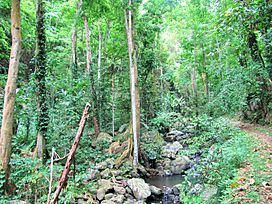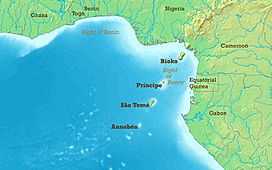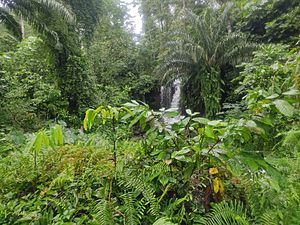São Tomé, Príncipe, and Annobón forests facts for kids
Quick facts for kids São Tomé, Príncipe, and Annobón forests |
|
|---|---|

forest on São Tomé
|
|

Map of the Gulf of Guinea, showing São Tomé, Príncipe, and Annobón. These islands, together with the island of Bioko and Mount Cameroon on the African mainland, are part of the Cameroon line of volcanoes.
|
|
| Ecology | |
| Realm | Afrotropical |
| Biome | tropical and subtropical moist broadleaf forests |
| Geography | |
| Area | 978 km2 (378 sq mi) |
| Countries | São Tomé and Príncipe and Equatorial Guinea |
| Coordinates | 0°15′N 6°36′E / 0.25°N 6.6°E |
| Conservation | |
| Conservation status | Vulnerable |
| Global 200 | yes |
| Protected | 323 km² (33%) |
The São Tomé, Príncipe, and Annobón forests are amazing places full of life! They are also called the São Tomé, Príncipe, and Annobón moist lowland forests. These are special types of tropical forests found on three islands. These islands are São Tomé and Príncipe, which make up the country of São Tomé and Príncipe. The third island is Annobón, which belongs to Equatorial Guinea.
Contents
Island Homes of the Forests
The three islands are actually volcanoes. They are part of a chain of volcanoes called the Cameroon Line. This chain stretches from Annobón in the southwest. It goes through São Tomé, Príncipe, and Bioko islands. Then it reaches the mainland as Mount Cameroon and other volcanoes.
Island Sizes and Ages
Príncipe is the island furthest north. It is also closest to the African mainland. Its area is about 128 square kilometers (49 square miles). São Tomé is the biggest island. It covers about 836 square kilometers (323 square miles). It lies southwest of Príncipe. Annobón is the island furthest south. It is also furthest from the African coast. Its area is about 17 square kilometers (6.6 square miles).
All the islands have mountains. The highest peaks are:
- São Tomé: Pico de São Tomé at 2,024 meters (6,640 feet)
- Príncipe: Pico do Príncipe at 948 meters (3,110 feet)
- Annobón: Pico Quioveo at 598 meters (1,962 feet)
Príncipe is the oldest island. Its rocks are 31 million years old. São Tomé is 14 million years old. Annobón is the youngest at 4.8 million years old. None of these islands have ever been connected to mainland Africa.
Tinhosas Islands: Seabird Havens
The Tinhosas islands are two small, rocky islands. They are about 22 kilometers (14 miles) south of Príncipe. Tinhosa Grande is 22 hectares (54 acres) big. It reaches 56 meters (184 feet) high. Tinhosa Pequena is 3 hectares (7.4 acres) big. It is 65 meters (213 feet) high. These islands are very important for seabirds. You can learn more about the animals here in Wildlife of São Tomé and Príncipe.
Amazing Plant Life
The islands naturally have many forests. The types of forests change based on how much wind and rain they get. They also change with how high up they are. Wet lowland forests grow on the south and southwest parts of the islands. These areas face the winds. Drier lowland forests are found to the north and east. These areas are in the islands' rain shadow.
Forest Zones by Elevation
On São Tomé, forests grow in different zones:
- Lowland forests: From sea level up to 800 meters (2,600 feet) high.
- Montane forests: From 800 to 1400 meters (2,600 to 4,600 feet) high.
- Cloud forests: Above 1400 meters (4,600 feet) high.
The higher montane forests and cloud forests have special plants. These plants are typical of afromontane areas. They include Olea capensis, Syzygium guineense, and Pauridiantha floribunda. There are also unique trees found only here. Some of these are Afrocarpus mannii, Tabernaemontana stenosiphon, Homalium henriquesii, Croton stelluliferus, Polyscias quintasii, and Craterispermum montanum.
Endemic Plants: Found Only Here
These islands are home to many plants found nowhere else.
- Príncipe has 37 plant species that are endemic (unique to the island).
- São Tomé has 95 endemic plant species. It also has one entire group (genus) of plants found only there.
- Annobón has 20 endemic plant species.
Only 16 of these unique plants grow on more than one island.
Wonderful Animal Life
Birds: Unique Species and Seabird Colonies
The islands are home to 143 types of birds. About 72 of these birds live and breed there all the time.
There are 28 bird species that are endemic to these forests. This means they live only here. All of them are forest birds.
- Seven species are found only on Príncipe. The unique olive ibis subspecies on Príncipe, B. o. rothschildi, is probably the rarest bird in this area.
- Sixteen species are found only on São Tomé. Two entire groups (genera) of birds are unique to São Tomé. These include the São Tomé ibis (Bostrychia bocagei), São Tomé olive pigeon (Columba thomensis), São Tomé scops-owl (Otus hartlaubi), São Tomé fiscal (Lanius newtoni), São Tomé shorttail (Amaurocichla bocagii), giant sunbird (Nectarinia thomensis), São Tomé grosbeak (Neospiza concolor) and São Tomé oriole (Oriolus crassirostris).
- Annobón has its own unique birds. These are the Annobón white-eye (Zosterops griseovirescens) and the Annobón paradise-flycatcher (Terpsiphone smithii).
Four other unique bird species live on two or more of the islands. For example, the Príncipe speirops (Speirops leucophoeus) and velvet-mantled drongo (Dicrurus modestus) live on both São Tomé and Príncipe. The São Tomé bronze-naped pigeon (Columba malherbii) lives on São Tomé and Annobón.
The Tinhosas islands are very important for seabirds. They have the largest seabird colonies in the Gulf of Guinea. Many birds come here to breed.
- Sooty terns (Onychoprion fuscatus): 100,000 breeding pairs.
- Black noddies (Anous minutus): 10,000–20,000 breeding pairs.
- Brown noddies (Anous stolidus): 4,000–8,000 breeding pairs.
- Brown boobies (Sula leucogaster): 1,500–3,000 breeding pairs.
- Small numbers of white-tailed tropicbirds (Phaethon lepturus).
Mammals: Bats and Shrews
This ecoregion is home to three types of mammals found nowhere else. They are all endemic species:
- The São Tomé shrew (Crocidura thomensis)
- The São Tomé collared fruit bat (Myonycteris brachycephala)
- The São Tomé free-tailed bat (Chaerephon tomensis)
Protected Areas: Keeping Nature Safe
In 2017, experts found that 323 square kilometers (125 square miles) of this ecoregion are protected. This means about 33% of the area is safe. These areas are called protected areas. They help keep the plants and animals safe.
Important protected areas here include:
- Obo Natural Park: This park covers parts of São Tomé and Príncipe islands. It also includes the Tinhosas islands.
- Annobón Natural Reserve: This reserve is on Annobón island.
See also
 In Spanish: Selva de tierras bajas de Santo Tomé, Príncipe y Annobón para niños
In Spanish: Selva de tierras bajas de Santo Tomé, Príncipe y Annobón para niños


